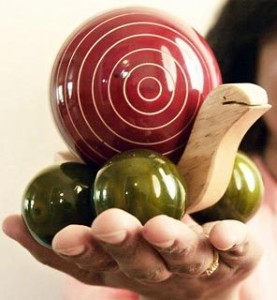
Expecting to see an old craftsman sitting in a quiet corner and chipping away on a piece of wood that would eventually turn into one of those dolls, Savitha was surprised to find the factory of Maya Organic where workers of varying ages chipped away on power lathes and crafting those toys.
Girish, who has been working on toys for the last 18 years, explains, “We are a family of toymakers. My father, now, 74 years old, my brother, all of us, have been working on making toys.” So, how have things changed over the years? I ask. “Things have changed. Earlier, people would work on hand lathes in their homes, or hire lathes, and then we would go to the toy emporiums and sell our toys. Life was difficult because we had to make ends meet on a daily basis. Now, with the factory, things are more streamlined, and it is no longer a daily wages thing. Also, back then, we would make saada bombe (plain toys).”
Once believed to have been the art of Persian toymakers, who were brought in by the Mysore ruler Tipu Sultan, the skill has undergone a host of changes to cater to the changing environment. With exports being the mainstay of the industry, the toys have also evolved to hold greater appeal to the western markets. The use of vegetable dyes is one such innovation, which makes these toys score over their more controversial lead-containing Chinese counterparts.
However, the picture still isn’t that rosy for these artisans:
An enquiry at a Handicrafts Emporium within the town brought a new perspective to the toy story.
The owner explains that while there are huge export orders, there is always the fear that such bulk orders get rejected even if there is a slight fault in one of the toys. And in the non-tourist season, on ordinary weekdays, there are not many people who actually buy toys from such shops in the town. And so, there is diversification, from the traditional toys to metalware, to incense sticks to sarees.
The Channapatna toys have been more than playthings for the many girls growing up in the town, offering them a means of livelihood and empowerment at the factory. Their story is intricately linked to the toy story of Channapatna.
Read the complete article here.
Image Courtesy: Seattle Times
If you found our stories insightful, informative, or even just enjoyable, we invite you to consider making a voluntary payment to support the work we do at The Better India. Your contribution helps us continue producing quality content that educates, inspires, and drives positive change.
Choose one of the payment options below for your contribution-
By paying for the stories you value, you directly contribute to sustaining our efforts focused on making a difference in the world. Together, let's ensure that impactful stories continue to be told and shared, enriching lives and communities alike.
Thank you for your support. Here are some frequently asked questions you might find helpful to know why you are contributing?

